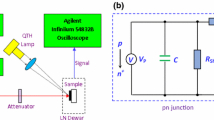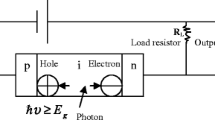Abstract
The minority carrier continuity equation has been solved with the Green’s function approach in a N/P photodiode under the low-level injection assumption. The analytical solution obtained with this approach depends on the three spatial coordinates and on time. The diffusion and the collection of the excess minority carriers have been studied during the transitional period corresponding to very short integration times. The internal Quantum Efficiency and the diffusion Modulation Transfer Function have been calculated according to time. The simulations showed that they evolve with time until their steady-state values. When the integration time is very short, this evolution has to be taken into account for the estimation of the sensitivity of a photodiode and the contrast on an image of a sensor based on several adjacent N/P-type photodiodes.







Similar content being viewed by others
References
Arai, T., Yonai, J., Hayashida, T., Ohtake, H., van Kuijk, H., Goji Etoh, T.: Back-side-illuminated image sensor with burst capturing speed of 5.2 Tpixel per second. Proc. SPIE Int. Soc. Opt. Eng. 8659, 865904 (2013)
Barbe, D.F.: Imaging devices using the charge-coupled concept. Proc. IEEE 63(1), 38–67 (1975)
Brown, R.W., Chamberlain, S.G.: Quantum efficiency of a silicon gate charge-coupled optical imaging array. Phys. Stat. Sol. A 20, 675–685 (1973)
Chen, O.T.-C., Liu, W.-J., Dai, L.-K., Weng, P.-K., Jih, F.-W.: Extended one-dimensional analysis to effectively derive quantum efficiency of various CMOS photodiodes. IEEE Trans. Electron Devices 54(10), 2659–2668 (2007)
Crowell, M.H., Labuda, E.F.: The silicon diode array camera tube. Bell Syst. Tech. J. 48, 1481–1528 (1969)
Djité, I., Magnan, P., Estribeau, M., Rolland, G., Petit, S., Saint-Pé, O.: Theoretical evaluation of MTF and charge collection efficiency in CCD and CMOS image sensors. Proc. SPIE 7427, 742705 (2009)
Etoh, T.G., Nguyen, D.H., Dao, S.V.T., Vo, C.L., Tanaka, M., Takehara, K., Okinaka, T., van Kuijk, H., Klaassens, W., Bosiers, J.: A 16 Mfps 165kpixel backside-illuminated CCD. IEEE ISSCC, pp. 406–407 (2011)
Etoh, T.G., Nguyen, A.Q., Kamakura, Y., Shimonomura, K., Le, T.Y., Mori, N.: The theoretical highest frame rate of silicon image sensors. Sensors 17(3), 1–15 (2017)
Gaury, B., Haney, P.M.: Minority-carrier dynamics in semiconductors probed by two-photon microscopy. In: IEEE 43rd PVSC, pp. 3037–3040 (2016)
Grove, A.S.: Physics and Technology of Semiconductor Devices. Wiley, New York (1967)
Ozisik, M.N.: Heat Conduction, 2nd edn. Wiley, New York (1993)
Ozturk, A., Arikan, M.C.: Green’s function approach to the continuity equation. In: Eleco’99, pp. 299–303 (1999)
Seib, D.H.: Carrier diffusion degradation of modulation transfer function in charge coupled imagers. IEEE ED–21(3), 210–217 (1974)
Sze, S.M., Ng, K.K.: Physics of Semiconductor Devices, 3rd edn. Wiley, Hoboken, NJ (2007)
’t Hooft, G.W., van Opdorp, C.: Determination of bulk minority-carrier lifetime and surface/interface recombination velocity from photoluminescence decay of a semi-infinite semiconductor slab. J. Appl. Phys. 60(3), 1065–1070 (1986)
Author information
Authors and Affiliations
Corresponding author
Additional information
This article is part of the Topical Collection on Numerical Simulation of Optoelectronic Devices, NUSOD’ 17.
Guest edited by Matthias Auf der Maur, Weida Hu, Slawomir Sujecki, Yuh-Renn Wu, Niels Gregersen, Paolo Bardella.
Appendix
Appendix
The transformed continuity equation for the excess minority electrons in the region III is
with the boundary conditions
To determine the appropriate Green’s function, we consider the homogeneous version of this problem as
We apply the technique of separation of variables and we assume a separation in the form
which leads to the differential equations: \(\frac{X''}{X} = -\beta ^2, \frac{Y''}{Y} = -\gamma ^2, \frac{Z''}{Z} = -\eta ^2\) and \(-(\beta ^2+\gamma ^2+\eta ^2) \varGamma = \frac{1}{D_n}\varGamma '\), where \(\beta , \gamma\) and \(\eta\) are constants. The solutions to these differential equations are the eigenfunctions of the Sturm-Liouville problem and are given by
For other boundary conditions than Eq. (24), one can easily calculate the eigenfunctions or use the Table 2-2 of Ozisik (1993). The complete solution is written as
The coefficients \(C_{abc}\) are (Ozisik 1993)
where \(N(\beta _a), N(\gamma _b)\) and \(N(\eta _c)\) are the normalizing factors of eigenfunctions. The substitution of Eq. (29) into Eq. (28) gives the solution as
We deduce from Eq. (30) the Green’s function
In order to calculate the Green’s function of the problem, we have considered an arbitrary initial condition F(x, y, z). After obtaining the Green’s function, the solution to (23) is given for any generation function, and any boundary condition by integration (Ozturk et al. 1999). In this article all the boundary conditions are of the first kind, except for the region I where there is a boundary condition of the third kind which is homogeneous. Moreover we consider that at \(t=0\) there is no light and no excess minority carriers. Hence the solution to (23) is
The generation function can be written in the form \(g(x,y,z)= l(x,y) \alpha \exp (-\alpha z)\) for any incoming light. The expression of the l function is \(l(x,y)=M\) for a spatially uniform photon flux and \(l(x,y)=M'\delta (x-l_1/2,y-l_2/2)\) for a point source of light. The expression (32) becomes
The function f is the same in the regions I and III, and is defined as
Rights and permissions
About this article
Cite this article
Peillon, C., Estribeau, M., Magnan, P. et al. Time-dependent internal Quantum Efficiency and diffusion Modulation Transfer Function of N/P photodiodes. Opt Quant Electron 49, 378 (2017). https://doi.org/10.1007/s11082-017-1213-2
Received:
Accepted:
Published:
DOI: https://doi.org/10.1007/s11082-017-1213-2




